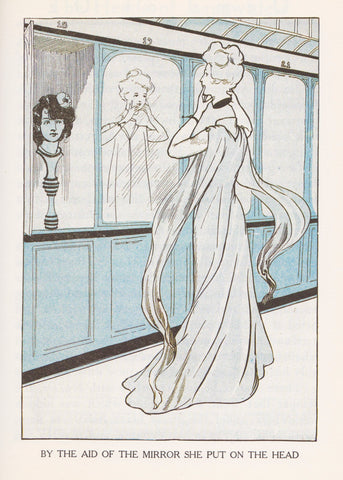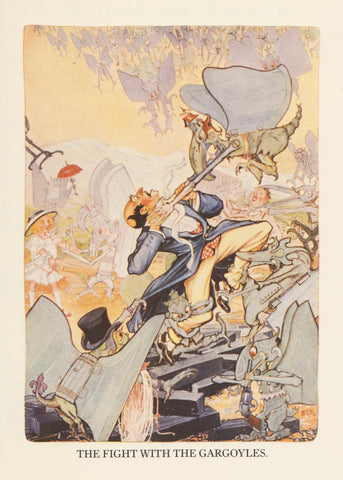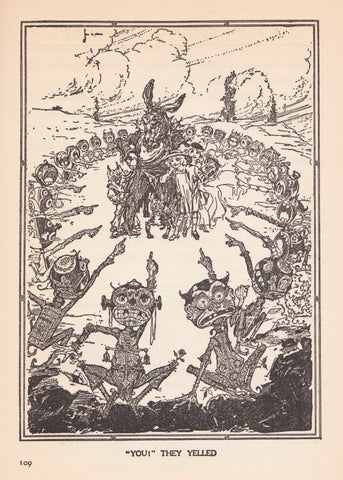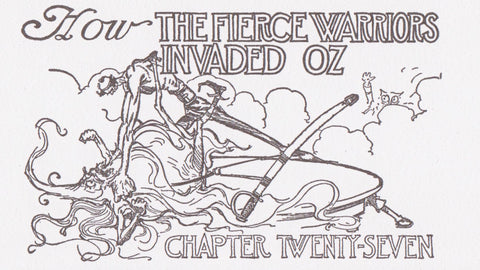 VISIT
MUSEUM STORE
MEMBERSHIP
OZ NEWS
CONTACT
VISIT
MUSEUM STORE
MEMBERSHIP
OZ NEWS
CONTACT
“DARK OZ”? I’M WITH FRANK (AND COMPANY) . . .

[Above: When Dorothy and Princess Ozma of Oz first met the Nome King, his eyes “turned merrily upon them,” and he displayed features so “kindly and good-humored” that Dorothy observed with quiet astonishment that he looked “like Santa Claus.” Yet the seemingly benevolent ruler of an almost limitless underground domain (and monarch of uncountable nomes) would swiftly become the sworn enemy of all Oz and its citizenry -- perhaps the most evil, frequent, and relentless combatant across decades of its history. This colorful depiction of the initially pleasant encounter between the Kansas girl, the ruler of Oz, and “Roquat of the Rocks” was drawn by the masterful Dick Martin for the 1961 picture book abridgement of L. Frank Baum’s OZMA OF OZ, a story originally published in 1907.]
Across almost sixty-four years as an Oz fan (and fanatic), I’ve enjoyed many different adaptations and configurations of the fantastic worlds and characters created by L. Frank Baum, his “Royal Historian” successors, and any and all of their illustrators. The Metro-Goldwyn-Mayer movie version of THE WIZARD OF OZ (1939) first led me to the Oz books; my passion for that film and all the multiple “histories” was immediately, happily indiscriminate, and this hasn’t much changed. They’ve provided personal excitement on virtually every day of my life since I was five years old.
I’ve also and enthusiastically enjoyed many of the new, diverse Oz efforts of the last few decades. I thought portions of Disney’s RETURN TO OZ carried their own magic, and there was even – indeed, infinitely -- more pleasure in the later OZ THE GREAT AND POWERFUL. Ditto the joys of the original Broadway production of THE WIZ (though not the film or recent tele-adaptation). And WICKED THE MUSICAL. And the AGES OF OZ novels. And the SILVER SHOES trilogy.
For all of that, however, I’m also going to confess that I have very little patience with -- or regard for -- the ongoing, on-growing obsession that some manifest (whether as creators or partisans) for “dark Oz.” I’m speaking strictly personally now, and to each his own, of course. But not for me the books that declare DOROTHY MUST DIE or take a WICKED approach; nor the widely-heralded, sex-and-violence cloaked TIN MAN and EMERALD CITY style dramatizations; nor the permeating twenty-first century (or earlier) predilection for foul language -- no matter how commonplace it has now and depressingly become; nor the revisionist character conceptions or predilections for death, destruction, decimation, and inhumane behavior. (I’ll spare you the obvious comparisons to the current world around us, adding only “Enough, already.”)
After being introduced to Oz via MGM in 1956, I initially devoured the forty official books in the Oz Series between 1957 and 1963. (I long-ago lost count of how many times I’ve since reread each of them.) During the first months of the current pandemic, I happily -- and therapeutically -- breezed through one and all again, and the process not only stirred welcome memories but led me to re-realize that the dark aspects of Oz actually have been part and parcel of the greater myth since its onset. The difference, however, is that the thrilling and dangerous moments of the stories were invariably tempered or resolved or even made humorous by the adept writings of Baum and his fellow scribes (or the depictions of those adventures by the illustrators). That’s “my” Oz – and maybe that holds true for some of you, too? Anyway, here’s a brief look-back at some of the happily scary, threatening, and very early dark Ozian moments . . . that somehow never went too far.

[Above: Though the Disney factory renamed her “Mombi” in RETURN TO OZ (1985), she was really Baum’s Princess Langwidere – read “languid air” – of OZMA OF OZ (1907), a self-absorbed narcissist completely preoccupied with her appearance. The fact that she had but one lovely style of gown never once sidetracked Langwidere’s self-adoration, and Baum made the reason for her complacency abundantly and amusingly clear (if with a definite dark or macabre undertone). Please keep reading, but please also enjoy Langwidere’s portrait from OZMA OF OZ, drawn by John R. Neill.]
As was discussed and illustrated up top, the real villain of Baum’s OZMA OF OZ is the Nome King, and there’ll be more about him as this blog progresses. Earlier in that story, however, Dorothy Gale – making her unexpected second visit and landing in a borderland-of-Oz realm – is tossed into a stone tower cell and served only bread and water, merely because she refuses to trade her own head for a cast-off belonging to Princess Langwidere of Ev. A regal pain in the neck (on a totally inimitable level), Langwidere never varies her style of wardrobe but instead possesses multiple different heads. If desirous of a change in appearance, she simply goes to her “cabinet” chamber, opens one of thirty mirror-faced and velvet-lined cupboards, and puts on the noodle of her choice. The princess is almost immediately dismissive of Dorothy when the child arrives at the castle of Ev, yet she finds herself taken with the girl’s “certain style of prettiness” and goes on to classify her as “rather attractive” though “not at all beautiful . . . .” The vain ruler off-handedly decides, “I believe I’ll take your head and give you [my] No. 26 for it.” Dorothy, understandably, refuses -- thus her imprisonment. She’s freed the next morning by the timely arrival of Ozma, the Scarecrow, Tin Woodman, Cowardly Lion, and a host of other Ozzies, so her incarceration is brief . . . but long enough for child readers (or listeners) to contemplate a highly original demand and threat. And no dinner.

[Above: The Wizard of Oz saves himself from threatened death at the hands of the Mangaboos and their sorcerer in Baum’s DOROTHY AND THE WIZARD IN OZ (1908]. This eye-opening Dick Martin “take” on the moment was drawn for an abridgement of that tale, published in 1961.]
Dorothy’s subsequent trip, in DOROTHY AND THE WIZARD IN OZ, occurs when an earthquake splits the ground in California, and the vacationing girl falls deep into the earth while riding in a buggy being driven by her cousin Zeb. He, his horse Jim, Dorothy’s kitten Eureka, and their conveyance all take the plunge with Dorothy; a little while later, the former Wizard of Oz himself (floating in his balloon) wafts down through another crack, and everyone meets in the Kingdom of the Mangaboos. Ruled by an unscrupulous (though at least semi-genuine) sorcerer named Gwig, these center-of-the-world dwellers have their own city, where they grow as plants, are picked when ripe, and then come to life; the interior physical composition of the Mangaboos, according to Baum, is much like that of a turnip or potato. In short order, however, the malicious Gwig resolves to destroy the Wizard and rid himself of a competing magician. He begins a magic ceremony designed to stop the Great Oz from breathing, and it’s a harrowing moment. Yet author Baum tops it just seconds later, when he instead has the Wizard -- with one slash of a sword -- self-defensively put an end to Gwig. This unexpectedly murky moment is saved from gore when the sight of a split sorcerer turns out to be no more harrowing than that of a sliced vegetable.

Later on in DOROTHY AND THE WIZARD IN OZ, the party of friends is attacked by scores of fearsome, flying, and gruesome Gargoyles. The Neill painting just above captures a moment of their battle, in which the wooden locals (temporarily) triumph, despite the valiant efforts of the Wizard to defend Dorothy; she is noticeable here on the far left. The artist somewhat takes the edge off the marauding creatures by giving them curious characteristics, even though Baum unconditionally describes them as “decidedly ugly . . . [and all] equally disagreeable in appearance.” When ultimately imprisoned by the Gargoyles, the Wizard comments to his comrades, “There is no doubt they intend to kill us as dead as possible in a short time.” (Dorothy concurs, in what may the classic example of sage Kansas understatement: “As dead as possible would be pretty dead.”) Our protagonists manage to escape by appropriating some of the gargoyles’ wings – the characters remove them to sleep – and thereafter fly to momentary safety. The Wizard then sets fire to the all-wood country, thus sparing future travelers any similar challenges, entrapment, or demise.

Similar death threats are faced in Baum’s THE ROAD TO OZ (1909). The cannibalistic Scoodlers – inhabitants of a barren country on the far side of the Deadly Desert -- seize Dorothy, Polychrome the Rainbow’s Daughter, Toto, the Shaggy Man, and little Button-Bright so that they can be made into soup. (Above, Neill depicts the Shaggy Man and Button-Bright with the donkey and fox heads they’d respectively been provided by well-intentioned but misguided rulers of other kingdoms earlier in their journey.) Frighteningly, the Scoodler Queen is the equal of her ravenous subjects. She has a brief audience with the detainees and then instructs her guards to “Take them away, and at six o’clock, run them through the meat chopper and start the soup kettle boiling. And put plenty of salt in the broth this time . . . plenty of onions and garlic and a dash of red pepper.”
One of the Scoodlers’ unique characteristics quickly and fortunately provides their downfall. When irritated, the creatures are capable of taking off their heads and throwing them at any who provoke them; thereafter, they run to retrieve the heads and are instantly fit for further combat. When the Shaggy Man realizes this, he effects the escape of his companions and then – as a baseball player of extensive experience! – confronts the Scoodlers en masse. Many simultaneously throw their heads to overcome the courageous Shaggy, but the latter catches one and all and tosses them into a deep, black gulf, rendering them irretrievable. Neill beautifully recreates the moment below.

Like the Gargoyles, the Scoodlers are hideous in appearance, and the threat of being served up to them, with vegetables and broth, was enough to make the most cynical boy or girl wide-eyed and apprehensive. The Shaggy Man’s escape plan and all-American catching arm neatly resolved the situation to any reader’s satisfaction: Dinner is NOT served – and this time, no child minded.
Earlier, we discussed the preliminary genialities of the Nome King in OZMA OF OZ. Within a few pages of that text, however, the “Metal Monarch” has laid plans to turn all of his visitors from Oz, Ev, and Kansas into ornaments and décor for his vast castle parlors. Failing that, he terrorizes them with promises of transformation into scorpions -- or with being hurled “into my underground dungeons, where the volcanic fires glow, and the molten lava flows in every direction, and the air is hotter than blue blazes.” How they escape is Baum plot construction and characterization at its best, but the King’s violent, vehement, and vengeful personality has been demonstrated for all-time.
The author brings the vicious elf back to the Oz Series three books later; in the intervening time, the bested cavern king has pondered complex designs for heinous revenge. Thus, in THE EMERALD CITY OF OZ (1910), Roquat orders his subjects to dig a massive tunnel, beginning in his Under World kingdom, leading beneath the Deadly Desert and Oz, and culminating in a spot just below the surface of the Emerald City gardens. Simultaneously, his General Guph enlists the aid of three groups of warrior monsters -- one aggregation more horrible and wicked than the other – all of whom will march through the finished tunnel with the Nome Army to lay waste to Ozma’s kingdom. (Prior to Guph, two other Nome commanders -- Generals Blug and Crinkle -- had refused to participate in Roquat’s plans for retaliation on Oz. As a result, and referencing Blug, the Nome King cavalierly and nonchalantly ordered his guards to “throw him away.” They were later instructed to cart Crinkle to “the torture chamber” and charged with then slicing “him into thin slices. Afterward, you may feed him to the seven-headed dogs.” Baum thus foreshadowed -- and topped! -- J. K. Rowling by both the four additional heads and an implied crew of more than one such animal. 😊 )

[Above: In this individual chapter heading for THE EMERALD CITY OF OZ, Neill has seemingly composited the tiny head of one of the Whimsies onto the skin, bone, and muscled body of a Growleywog, and General Guph of the Nomes is momentarily under attack. No matter; those three tribes -- plus the “shape-shifting” Phanfasms -- are about to set out on a mission to utterly destroy Oz and take the celebrity residents as slaves.]
The malevolent militaries arrive in Oz at the penultimate moment of Baum’s book, and only the famous brains of the Scarecrow manage to contrive a scheme that will save Ozma’s country from such horrific hordes. In the Scarecrow’s solution – and best of all -- no one is hurt, harmed, or injured, and the hatred of most of the miserable minions is, however briefly, flushed away. (You’ll have to read the book!)

In that process, the Nome King himself (as “photographed” here by Neill) is also briefly cured of his dreadful desires. He manages, however, to eventually sulk, scheme, pout, whine, rant, rebel, terrorize, and menace Oz or its inhabitants in at least seven more books. Each time, the prospective scourge is unquestionable; each time, there’s the potential for Oz to become a fallow wilderness.
Remember, too, that it isn’t just the hovering danger of the Nome King that imperils Oz for real. Throughout the book series, there is also disparate darkness threatened by Mombi the Witch, Mr. Yoop the Giant, Mrs. Yoop the Yookoohoo (and Artist in Transformations), Quiberon the Sea Monster, the nefarious Sultan of Samandra, Mooj the Magician, Strut of Stratovania, Faleero the Witch, Terp the Terrible, the rascally Wizard of Wutz, the Magical Mimics, and Conjo the Conjuror.
Among many others.
These creatures of the night, the air, the water, the mountains, the caverns, the clouds, the deserts, and the woods invariably shade the stories, create the tensions, plague the plots, and twist the lives of those we love in Oz. And – hey! wow! – as dark as they are, they’re also pretty much one and all devoid of blood, guts, profanity, vivisection, crucifixion, bitchery . . . and etc.
Or, to quote Oscar Hammerstein II’s lyric from OKLAHOMA!: “And THAT’S about as fer as AH kin go!”
Meanwhile, no matter how similar or diverse your own opinions: THANK YOU for reading!
Article by John Fricke





